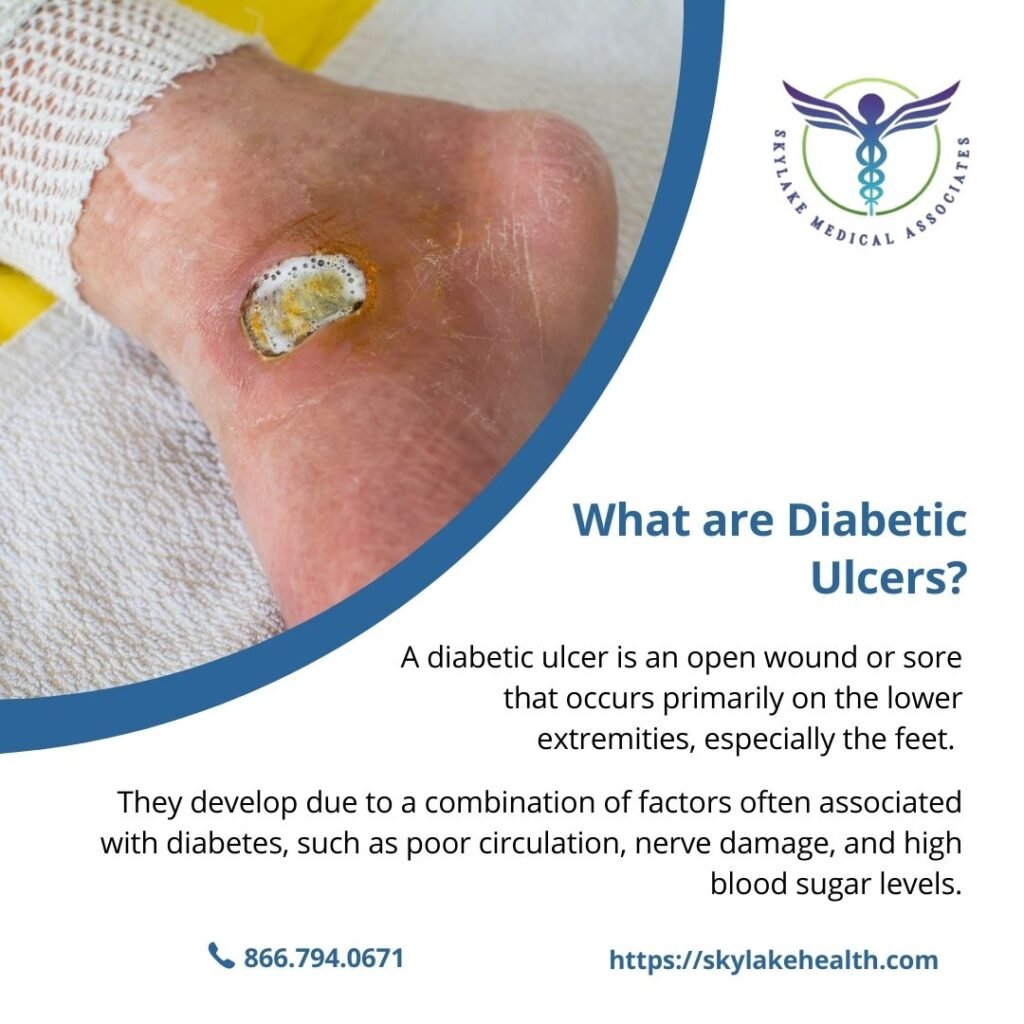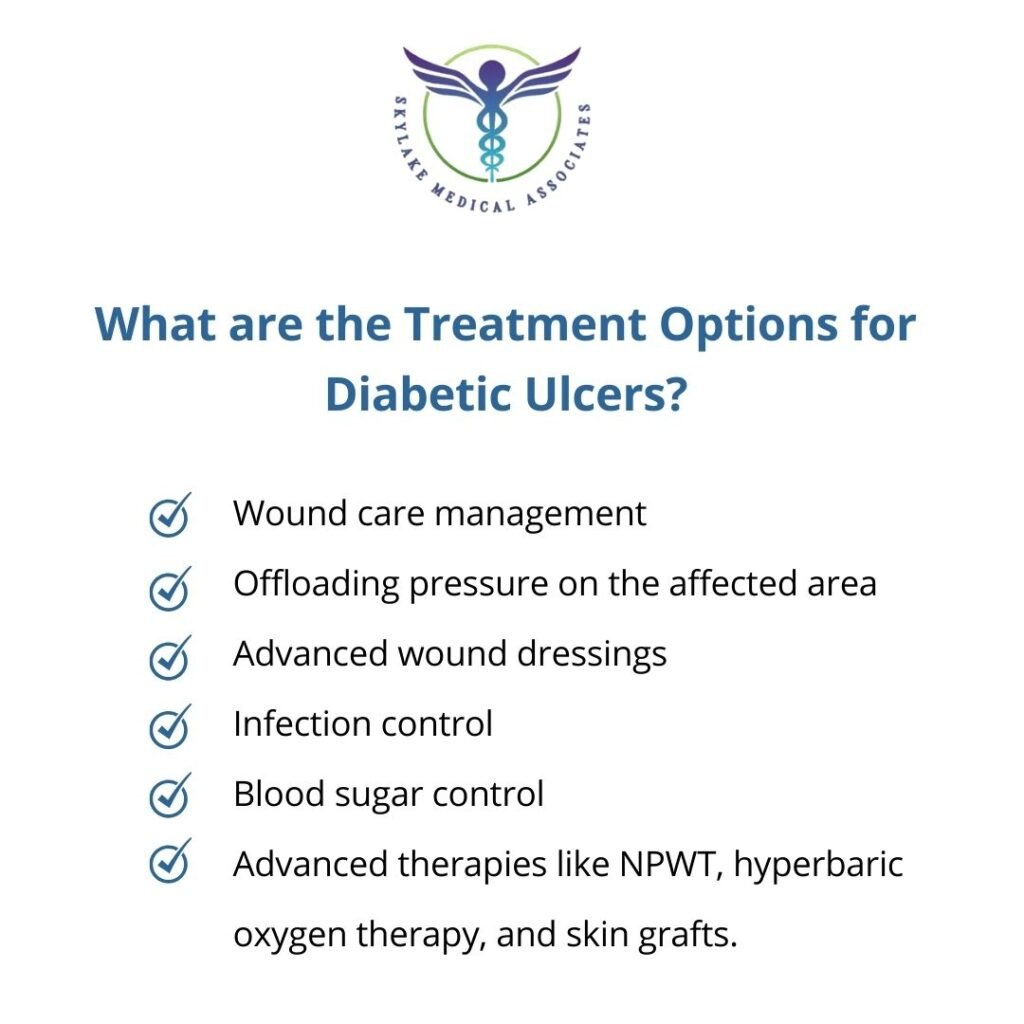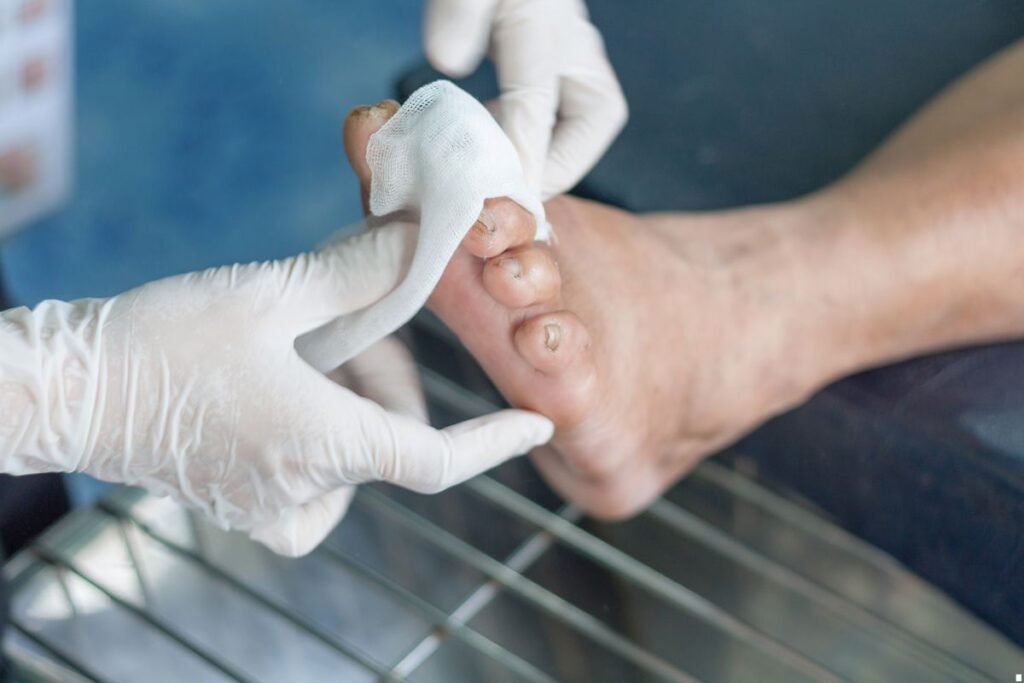Diabetic ulcers are a serious complication of diabetes, affecting a significant portion of the diabetic population. In fact, studies revealed that about one-third of people living with diabetes will develop a foot ulcer at some point in their lives.

Unfortunately, these open sores can lead to significant discomfort and even more severe health issues if left untreated.
In this blog post, we will provide a comprehensive understanding of diabetic ulcers, including their causes, prevention strategies, and effective treatment options.
What are diabetic ulcers?
A diabetic ulcer is an open wound or sore that occurs primarily on the lower extremities, especially the feet. They develop due to a combination of factors often associated with diabetes, such as poor circulation, nerve damage, and high blood sugar levels.
Diabetic ulcers, if untreated, can lead to serious complications, including infections, gangrene, or even amputation. Early detection and proper management are critical to preventing these outcomes.
What causes diabetic ulcers?
Several factors contribute to the development of diabetic ulcers, such as:
- Neuropathy
Nerve damage—a common complication of diabetes—affects foot sensation. This can lead to injuries going unnoticed, worsening them and potentially developing into ulcers.
- Peripheral artery disease (PAD)
PAD restricts blood flow to the extremities, including the feet. Insufficient blood supply hinders the healing process and increases the risk of infection.
- Foot deformities
Conditions like hammertoes, bunions, and Charcot’s foot can increase pressure on specific areas of the foot, making them more susceptible to injury and ulcer formation.
- Poor foot care
Neglecting proper foot hygiene, wearing ill-fitting shoes, and failing to inspect feet regularly can increase the risk of injury and ulcer development.
- Smoking
Smoking further restricts blood flow, exacerbating the effects of PAD and hindering wound healing.
What are the signs and symptoms of a diabetic ulcer?
Recognizing the early signs of a diabetic ulcer can significantly improve outcomes. Common symptoms include:
- Persistent pain or discomfort in the foot
- Swelling, redness, or inflammation
- Drainage from the wound or a foul odor
- Skin discoloration around the affected area
- Thickened or hardened skin around the sore
If you notice any of these symptoms, seek medical attention immediately from a podiatrist in North Miami Beach.
What are the treatment options for diabetic ulcers?
When prevention isn’t enough, prompt treatment is essential. Depending on the severity of the ulcer, treatment options range from basic wound care to advanced medical interventions.

1. Wound care management
Effective wound care is the foundation of treatment for diabetic ulcers. Here’s what you or your foot and ankle doctor may perform or recommend.
- Wound cleaning: Use saline or a mild antiseptic solution to clean the wound and remove debris. This prevents infection and promotes healing.
- Debridement: Removing dead or infected tissue improves circulation and encourages healthy tissue growth. This can be done surgically, chemically, or through advanced techniques like enzymatic debridement.
2. Offloading pressure
Using special shoes, insoles, or orthotics can reduce pressure on the wound. Total contact casting or specialized boots can also help redistribute weight and prevent further damage to the ulcer site.
3. Advanced dressings
Various wound dressings may be used to promote healing and protect the wound. Some examples include:
- Moist wound healing: Dressings that maintain a moist environment, such as hydrocolloid or hydrogel dressings, speed up healing.
- Antimicrobial dressings: Silver, iodine, or honey-infused dressings help fight infection.
- Foam dressings: Provide cushioning and absorb excess wound exudate, preventing maceration.
4. Infection control
Physicians may prescribe medications to help prevent or control infection in the affected area. They may either use:
- Topical antibiotics: Applied directly to the wound to prevent or treat localized infections.
- Systemic antibiotics: Prescribed if the infection spreads or becomes severe.
5. Blood sugar control
High blood sugar impairs the body\u2019s ability to heal wounds. Monitoring and maintaining optimal blood glucose levels is crucial.
6. Advanced therapies
- Negative pressure wound therapy (NPWT): A vacuum-assisted device removes fluid and increases blood flow to the wound.
- Hyperbaric oxygen therapy (HBOT): Delivers high oxygen levels to the tissues, promoting healing and fighting infections.
- Skin substitutes or grafts: Bioengineered skin or grafting techniques can cover large or deep wounds to promote healing.
7. Surgical intervention
In extreme cases where the ulcer does not respond to other treatments, surgical options, including vascular surgery or amputation, may be considered.
8. Lifestyle modifications
In addition to medical treatment, lifestyle modifications can significantly impact the healing process and prevent future ulcer occurrences.
- Healthy diet: A balanced diet rich in fruits, vegetables, and whole grains can help maintain healthy blood sugar levels and support the immune system.
- Regular exercise: Regular physical activity improves circulation and overall health, promoting faster wound healing. Consult your doctor for guidance on safe and appropriate exercise routines.
- Stress management: Stress can negatively impact blood sugar control and the healing process. Explore stress-reducing techniques such as yoga, meditation, or deep breathing exercises.
How to prevent diabetic ulcers?
Preventing diabetic ulcers starts with proactive foot care and overall health management. Below are practical tips to reduce your risk:
Practice daily foot care
Inspect your feet daily for cuts, blisters, or signs of infection. Wash your feet with mild soap and lukewarm water, and dry them thoroughly, especially between the toes.
You can also moisturize your feet to prevent dryness, but avoid the areas between your toes to reduce the risk of fungal infections.
Choose proper footwear
Wearing well-fitted, supportive shoes can help prevent pressure points and reduce injury risk. Consider custom orthotic inserts if you have specific foot concerns.
Control blood sugar levels
Maintaining blood sugar within your target range improves overall health, accelerates wound healing, and reduces infection risk.
Schedule regular checkups
Regular visits to your primary care in North Miami Beach can help detect early signs of foot issues before they become severe.
Quit smoking
Smoking impairs circulation, making it harder for wounds to heal. Quitting can greatly enhance your recovery prospects.
Skylake Medical: Your Partner in Diabetic Foot Care and Wellness
When it comes to managing diabetes, proper foot care is essential to avoid complications such as diabetic ulcers.

At Skylake Medical, we understand the challenges of patients with diabetes, and we’re here to help you take control of your health. Our comprehensive services, expert care, and patient-centered approach make us the premier choice for diabetic foot care and treatment.
Our team also specializes in providing primary care and foot-related services, including:
- Laser treatment,
- Skin graft,
- Regenerative medicine,
- Stem cells
- Exosomes
- Wound care in North Miami Beach,
And more!
Contact us today to schedule an appointment.
The material contained on this site is for informational purposes only and DOES NOT CONSTITUTE THE PROVIDING OF MEDICAL ADVICE, and is not intended to be a substitute for independent professional medical judgment, advice, diagnosis, or treatment. Always seek the advice of your physician or other qualified healthcare providers with any questions or concerns you may have regarding your health.

